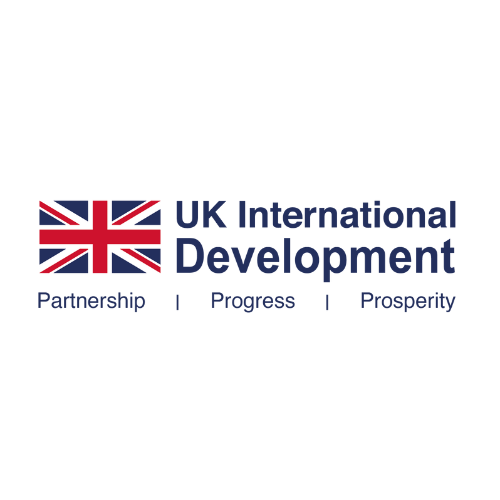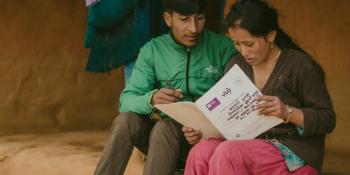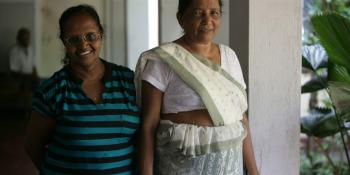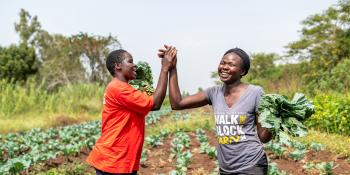This research project is a collaboration between VSO and the Centre for International Development at Northumbria University.
Background
Volunteering has long been a key part of development programming, but research, policy-making and
popular debate have been dominated by a focus on international volunteers and the systems supporting
them. This has meant that the interests of volunteers and communities in and from the global South have
not been prioritised. This needs to change if volunteering for development approaches are to provide a
demonstrable contribution to development outcomes.
Blended volunteering is a flagship approach for VSO in the field, differentiating its work from other
volunteer-involving organisations. It brings together volunteers from the local community and other
parts of the global South alongside volunteers from the global north with the aim that their collective
experiences can be synergised on projects to maximise impact. Volunteers working together is not new,
but VSO’s blended approach aims actively to maximise the opportunities such blends can offer.
This collaborative research project examines how such blends have operated in three case study
locations: Nepal, Tanzania and Uganda. A participatory approach has been utilised to gather qualitative
data through workshops and semi-structured interviews with volunteers, community representatives and
VSO staff. The findings have been supplemented by a quantitative self-completion questionnaire for
volunteers in the three case study countries.
This summary sets out our key findings, and the implications these have for policy, practice and our
knowledge base
Key findings
The research confirms the value that blended volunteering can bring to development projects. The presence of international volunteers brings energy and donor attention to projects, whilst community and national volunteers enable effective engagement with local communities and increase the likelihood that impacts can be sustained due to their particular knowledges and longer-term involvement.
However, there is no simple one-size-fits-all approach that can be applied to constructing a blend of volunteers, as the combination is dependent on the individuals within each blend, the environment around the project and the phasing of the work itself. Therefore, we have identified three sets of key findings for understanding and designing blended volunteering that can improve development outcomes.
1) There is no single prescribed blend applicable to all projects
The expansive nature of the blend
The blended approach to volunteering is predicated on bringing place-based volunteering modalities to work together: international, national and community volunteers. However, our data show that this categorisation does not reflect the full range of ways the blends are experienced and made sense of on the ground. Our research reveals how participants recognised and used a wider diversity of modalities, and that volunteering modalities often overlap.
This varied between contexts, and also between international and other modalities; there was greater clarity around the different modalities within the ‘international’ than there was within the ‘community’ category. Recognising how participants understand modalities, and the ways they can be fluid and overlap, responds to and challenges the ways research on volunteering has often used institutional and project languages rather than those of volunteers and participants themselves.
Mapping skills and modalities
Our research shows that VSO staff are committed to finding the ‘right’ blend at the start of project design, based on their understanding of the different skill sets and knowledges that particular modalities bring. However, the data shows that skill sets and knowledge do not always map neatly onto volunteer modalities. Importantly, across all country contexts, the skill sets of international volunteers are not as distinct from other modalities as has sometimes been assumed. This supports wider critiques of the ways development thinking has been characterised by assumptions about the global north’s possession of unique knowledge and skills to guide development.
Therefore, our research shows the importance of recognising the skills and attributes of volunteers beyond their geographies to avoid the risk of community volunteers’ roles being framed solely around their contextual knowledge in contrast with the technical expertise of international volunteers, for example. This points to the importance of identifying the skills for delivering the project, rather than reproducing assumptions of what particular place-based modalities might bring.
Modalities emerge organically in response to context/circumstances
Our research shows how volunteer modalities can emerge on the ground in response to project needs and particular country contexts. This reveals a bottom up emergence of role-based as opposed to geography based modalities, which reflect both operational demands, but also the ways that participants may wish to be recognised and understood. This can even include not being referred to as a ‘volunteer’, confirming wider and emerging evidence on the instability and contested nature of what being a volunteer means in particular places, something that adds a further layer of complexity to defining the blend in different contexts.
The blend as agile and dynamic
Our findings show that a blended approach can enable flexibility and adaptability to circumstances to support more effective delivery of development outcomes. The value of the emergence of modalities to suit a changing context was starkly revealed during the Covid-19 pandemic, but is also relevant to ensuring programme design reflects local knowledges, needs and priorities. The fact that some volunteers work across projects and that skills do not necessarily reflect the expectations often attached to geographic modalities is consequently a strength of blended volunteering in practice.
2) Community volunteers are crucial to the effectiveness of each blend but their contributions risk being sidelined
Steering the blend from the community level
The research identified diverse positive benefits from the blended approach, with the opportunity to share ideas and knowledge across backgrounds as particularly important for both individuals and projects. While the blend is important, community volunteers were identified across the country case studies as critical to the blended approach due to their knowledge and expertise, including context specific experiences, which can hold the blend together; acceptance and embeddedness, ensuring strong relationships with primary actors and their needs steering the blend; and longevity and sustainability, with their sustained involvements supporting long-term impacts and legacy. The research reveals the importance of local actors and community volunteers driving a blend, supported by inputs from external actors as appropriate.
Challenging hierarchies of knowledge and practice
The distinctiveness of volunteer modalities which can be complementary in application is central to the blended approach, but it can also lead to perceived or actual hierarchies between volunteer modalities. Differing mobilities, contracts and conditions, and expectations on and from volunteers can be particularly significant.
National and international volunteers are supported with re-location logistics, and role descriptions often characterise these volunteers in terms of skill sets, and community volunteers in terms of geographic presence and contextual knowledges. Outsiders can also be perceived as ‘managers’ and community volunteers as doing the delivery, exacerbated when interactions were confined to institutional settings and meetings, rather than working together over time to deliver activities.
Further inequality can be seen in the pressures sometimes felt by community volunteers given their centrality to making a blend work and deliver. At the same time, there are also hierarchies within modalities, including in relation to gender and wider social norms, underlining the importance of not homogenising any volunteer categories within a blend, and recognising how the blend is entwined with its particular context.
3) The success of the blend is dependent on contextual factors
Placement lengths and handover
How the blend works over time is a critical aspect of understanding what makes a successful blend. The research shows how volunteers come and go throughout the course of project, meaning the blend changes over time. It also reveals how the working together that is at the heart of the blend tends to improve over time. However, because some volunteers may have shorter placements, particularly international and national volunteers, this can mean extra time is needed to bring them on board within an existing blend.
Project phase is important to this, with volunteers joining towards the end of a project sometimes finding it harder to fit in, when working practices in the blend are already established. The blend may also not always contain all the planned modalities, or some modalities may not blend as easily. The research suggests that as well as blending modalities, blending between ‘coming’ and ‘going’ volunteers could help ensure the right skills and knowledge are sustained through the project.
The roles of long-term volunteers
Very long-term volunteers (over one year) are particularly important for the blend. They can support the smooth transition of other volunteers into a project, acting as a ‘glue’ that holds the blend together. The long-term commitments of community volunteers can be particularly important for maximising impact and building relationships within the blend and with primary actors and stakeholders over time. However, very long-term volunteers can also shoulder a disproportionate responsibility for delivery given their range of connections and knowledge.
Community experiences and expectations in the wider blend
When understanding the blended approach, particular consideration needs to be given not only to the relationships between volunteers in a blended team, and the various stakeholders and communities they work with, but also to the relationships between those stakeholders and the primary actors. The wide range of actors involved in a blend means it is particularly important that there is recognition of the diverse ways projects, project aims and outcomes are understood by different stakeholders.
Developing a sense of shared ownership across this complexity is important, particularly with primary actors and key stakeholders. This demands strong communications, something that the research identifies is enhanced by blending international, national and community volunteers to work together.
Integrations and overlaps
As well as volunteer modalities being fluid and role specifications within modalities also being emergent, the research reveals movement between the categories of ‘primary actor’, ‘volunteer’ and ‘partner’. This movement can help foster community buy-in, such as when volunteers are recruited from primary actors, bringing existing project knowledges and skills. How this fluidity works varies between contexts, and is shaped by the particular ways development organisations, and VSO in particular, work in a place. This means that categories such as ‘partner’ can mean different things for a blend, highlighting that each blend needs to be understood in its particular context.
Implications for policy and practice
Our research confirms that incorporating locally based volunteers into a project delivery team offers clear benefits: such blends foster a culture of innovation and adaptability, and their longer-term presence increases the likelihood of sustained impact.
Such arrangements are not without challenge; the process of blending cannot be specified top-down and instead the onus is on facilitating and empowering the development of such relations. This involves addressing perceived inequalities so that local volunteers can be confident that their contribution is valued.
Implications for research and knowledge
This research has addressed a significant gap in knowledge on volunteering for development by focusing on the volunteering assemblage that is produced through a blended approach and conceptualising how this generates a more de-centralised and sustainable approach to development. It is important, however, that the longitudinal impacts are examined further and that potential barriers to progress are explored.
Longitudinal analyses are needed to examine the ways different volunteers and primary actors evolve over time in response to changing circumstances. Furthermore, it is important to understand how the facilitation of such blends might be developed to overcome other potential barriers that might arise, such as gender inequalities.

Read the full report (PDF, 5.04MB)
Case studies
- Tanzania case study report (PDF, 886KB)
- Nepal case study report (PDF, 1,067KB)
- Uganda case study report (PDF, 1,001KB)
Authors: This executive summary and the accompanying report were prepared by Prof Matt Baillie
Smith, Prof Katy Jenkins, Dr Inge Boudewijn, Bianca Fadel and Dr Phil Gibby (UK), Dr Egidius
Kamanyi (Tanzania), Dr Moses Okech, Christine Adong, Gina Mary Angaun (Uganda), Dr
Jeevan Baniya, Preshika Baskota, Sita Mademba and Rajendra Sharma (Nepal).
For more information please contact Amy Fallon on amy.fallon@vsoint.org or on + 44 7494 188 269.
Find out more

Our research
Our research helps us continuously improve, innovate and shape our development priorities.

Our evaluations
Timely evaluation plays a critical role in understanding the contribution we make in delivering sustainable development.

Volunteering for development
Our unique volunteering for development approach puts the most marginalised people first.
